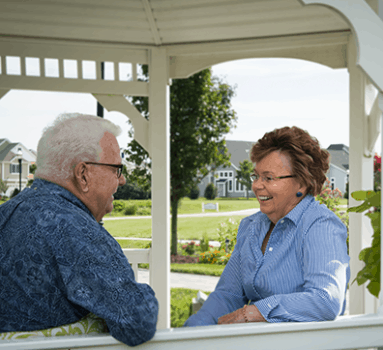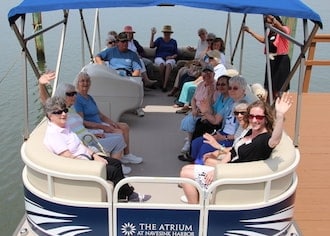How Dietary Needs Change In Your 60s and 70s
January 21, 2022
It’s a fact of life. Our metabolism slows as we age. But that doesn’t mean you need to toss in the towel. With some mindful edits to what you eat, and getting fresh air, plus a brisk walk or other exercise as part of your daily routine, you can help ensure a healthier you in your older years.
First a few key facts about aging and nutritional needs of seniors:
- As you age, you may need fewer calories to maintain your weight. That’s because, on average, older adults carry less muscle and are less active, so it doesn’t take as many calories to keep your body going.
- One of the more critical nutritional changes in seniors is is that they tend to not process food as efficiently as younger people, so you may not get the nutrients you need most.
- Certain medications often taken by older adults can reduce your ability to properly absorb nutrients.
The Building Blocks of Optimum Senior Nutrition
You probably recall reminding your kids to take their vitamins and eat their vegetables to grow up big and strong. Now it’s your turn. Vitamins and minerals become especially important as you age and are key to maintaining the proper nutritional needs of seniors.
Here are 6 key vitamins and minerals important to your dietary needs:
- Vitamin D–Sunlight exposure (20 minutes a day) is ideal for getting enough Vitamin D, but you can also get D from eggs (with yolks) and oily fish like salmon, sardines, and mackerel. Also look for fortified foods containing Vitamin D such as some buttery spreads and breakfast cereals. As a simple rule of thumb, adults over 70 should shoot for 800 IU per day, but it’s best to consult with your physician for your specific needs.
- Calcium–Healthy bones count on calcium, and it’s also necessary for proper nerve and muscle function. Lack of enough calcium can lead to osteopenia and osteoporosis, which puts you at risk for bone fractures (especially postmenopausal women). Good sources of calcium include milk, yogurt, cheese, fish with soft edible bones such as sardines and salmon, almonds, and calcium-enriched milks. As a simple rule of thumb, men over 70 and women over 50 need 1,200 milligrams per day, but it’s best to consult with your physician for your specific needs.
- Potassium–Keeping your potassium levels in balance can help lower your risk of high blood pressure–so keep salt intake in check. If you take diuretics, they may lower your potassium levels and cause leg cramps or heart issues, so it’s equally important to ensure you’re getting enough. Fruits, as well as vegetables, beans, and low-fat or fat-free dairy products are all good sources of potassium. Consult with your physician for your specific needs.
- Vitamin B12–As we age, our ability to absorb this important nutrient decreases. This is an issue because B12 is essential for producing red blood cells, maintaining the nervous system, and releasing energy from food. Adding these foods to your diet can help–liver, mackerel, fortified soya milk alternatives, yogurt, most meats, salmon, cod, milk, cheese, eggs, and fortified breakfast cereals. Consult with your physician for your specific needs.
- Protein–Protein is an essential nutrient, allowing our bodies to build and maintain tissue, cells, and muscle; make hormones; and produce antibodies. Studies suggest that eating more protein as we age can help minimize the muscle loss associated with aging. Good sources of protein include beef, pork, poultry, oily fish such as salmon and cod, and seafood such as prawns. Dairy products such as milk, cheese, and yogurt are suitable sources for vegetarians, while vegan sources include beans, nuts, seeds, quinoa, soy, and tofu.
- Iron–Good sources of iron include meat, poultry (such as chicken), fish, and whole-grain cereals. If you don’t get enough of these iron-rich foods, you put yourself at risk for developing anemia. Keep in mind that iron deficiency develops gradually—there are usually no symptoms until a person develops anemia. Symptoms of anemia can include dizziness, fatigue, irregular heartbeat, memory issues,and difficulty concentrating. To be sure your iron levels are where they should be, speak with your doctor. You may need to add an iron supplement to your diet.
Follow the Senior Food Pyramid
When it comes to the nutritional needs of seniors, the American Heart Association and Silver Sneakers recommend that your food plate resemble a rainbow. Their dietary guidelines for seniors suggest:
- Half of your plate should contain colorful vegetables and fruits (red, orange, green, and purple).
- One quarter of your plate should contain whole grains (brown rice, whole-wheat pasta, whole-wheat bread, oatmeal, etc.)
- The remaining quarter of your plate should contain protein such as beans, fish, poultry, and nuts. You can also include low fat milk, low fat yogurt, and cheese in moderation.
Additionally, be sure to:
Drink enough water. Aim for around 64 oz. per day. For variety, you can also try fluid-filled foods like fruit and soup, or drink milk, sugar-free drinks, tea, and coffee. Be sure to avoid caffeinated drinks, since these will cause you to urinate more often and delete your hydration more quickly.
Get enough fiber. Start with natural sources such as whole grains, oats, fruits, vegetables, beans, and lentils. Fiber is also filling, which can help make you feel fuller and less apt to snack too much. Before you add fiber supplements though, talk with your doctor. Fiber can slow down absorption of certain medications.
We’re All About Healthy Eating and Healthy Living
At the Atrium at Navesink, everything we offer is focused on helping you live life to the fullest–and at your healthiest. That includes serving delicious healthy foods in our dining room and offering our outstanding LivWell program to put you on a journey toward whole-person wellness from head to toe. Get in touch and let’s schedule a tour so you can see the good life for yourself!




